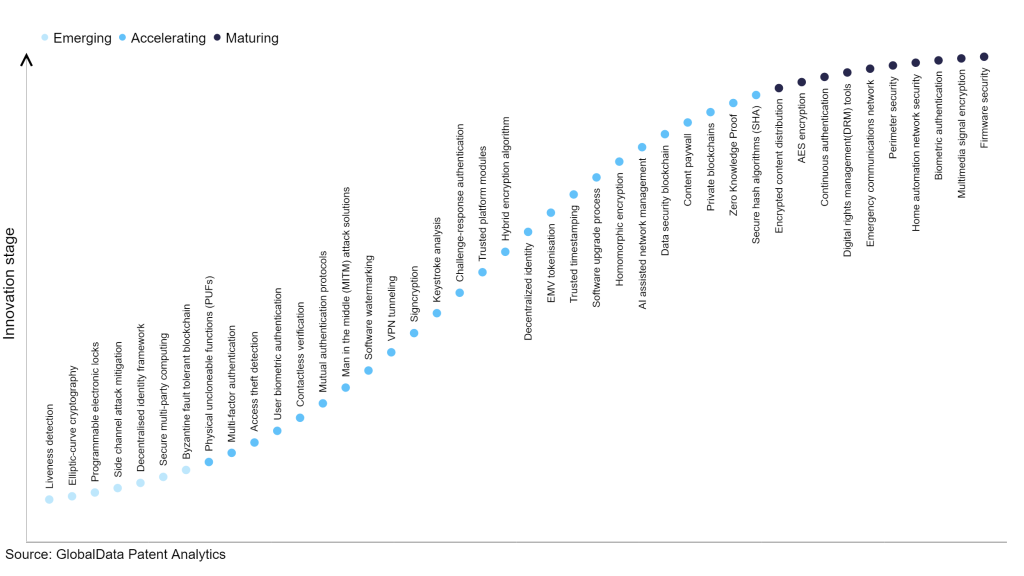The technology industry continues to be a hotbed of innovation, with activity driven by factors such as the increasing need for stronger security measures, the rising prevalence of cyber threats, the demand for convenient and user-friendly authentication methods, and growing importance of technologies such as fingerprint scanners, facial recognition systems, iris scanners, and voice recognition technologies. These technologies provide robust and reliable authentication, reducing the risk of unauthorized access and enhancing overall cybersecurity. As organizations prioritize user-centric security solutions, biometric authentication plays a pivotal role in ensuring secure and seamless user access to digital systems. In the last three years alone, there have been over 3.6 million patents filed and granted in the technology industry, according to GlobalData’s report on Innovation in Cybersecurity: User biometric authentication. Buy the report here.

Access deeper industry intelligence
Experience unmatched clarity with a single platform that combines unique data, AI, and human expertise.
However, not all innovations are equal and nor do they follow a constant upward trend. Instead, their evolution takes the form of an S-shaped curve that reflects their typical lifecycle from early emergence to accelerating adoption, before finally stabilising and reaching maturity.
Identifying where a particular innovation is on this journey, especially those that are in the emerging and accelerating stages, is essential for understanding their current level of adoption and the likely future trajectory and impact they will have.
300+ innovations will shape the technology industry
According to GlobalData’s Technology Foresights, which plots the S-curve for the technology industry using innovation intensity models built on over 2.5 million patents, there are 300+ innovation areas that will shape the future of the industry.
Within the emerging innovation stage, byzantine fault tolerant blockchain, secure multi-party computing, and decentralised identity framework are disruptive technologies that are in the early stages of application and should be tracked closely. Secure hash algorithms (SHA), zero knowledge proof, and private blockchains are some of the accelerating innovation areas, where adoption has been steadily increasing. Among maturing innovation areas are, firmware security, multimedia signal encryption, and biometric authentication, which are now well established in the industry.
Innovation S-curve for cybersecurity in the technology industry

User biometric authentication is a key innovation area in cybersecurity
User biometric authentication employs physical or behavioral traits to verify and authenticate the identity of individuals. It utilizes characteristics such as facial features, fingerprints, iris patterns, hand geometry, voice recognition, and more. These unique biometric identifiers serve as the basis for authenticating and validating user identities.
GlobalData’s analysis also uncovers the companies at the forefront of each innovation area and assesses the potential reach and impact of their patenting activity across different applications and geographies. According to GlobalData, there are 290 companies, spanning technology vendors, established technology companies, and up-and-coming start-ups engaged in the development and application of user biometric authentication.
Key players in user biometric authentication – a disruptive innovation in the technology industry
‘Application diversity’ measures the number of different applications identified for each relevant patent and broadly splits companies into either ‘niche’ or ‘diversified’ innovators.
‘Geographic reach’ refers to the number of different countries each relevant patent is registered in and reflects the breadth of geographic application intended, ranging from ‘global’ to ‘local’.
Samsung Group is a leading patent filer in user biometric authentication. One of the company’s patents is for a device that uses biometric information to remove security from content. The device includes a memory to store the content with security based on the user's first biometric information, and a controller to obtain the user's second biometric information of a different type and remove the security from the content based on the second biometric information when the user initiates the execution of the content.
Other prominent patent filers in the space include Apple and SoftBank Group.
By geographic reach, Black Gold Coin leads the pack, followed by Licentia Group and Authentify. In terms of application diversity, Tesseract Health holds the top position, followed by PPIP and Johnson & Johnson.
Cybersecurity innovation in user biometric authentication has transformed the way individuals are authenticated and authorized to access digital systems. This innovation leverages unique biological traits, such as fingerprints, facial features, or iris patterns, to verify and authenticate user identities. To further understand how cybersecurity is disrupting the technology industry, access GlobalData’s latest thematic research report on Cybersecurity – Thematic Research.
Data Insights
From

The gold standard of business intelligence.
Blending expert knowledge with cutting-edge technology, GlobalData’s unrivalled proprietary data will enable you to decode what’s happening in your market. You can make better informed decisions and gain a future-proof advantage over your competitors.







